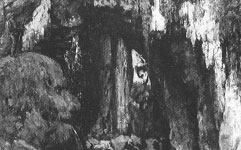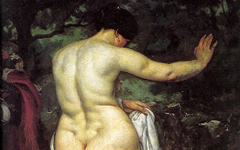Courbet’s Woman in a Riding Habit or The Amazon (1856)

Courbet, Woman in a Riding Habit or The Amazon (1856) Oil on canvas. Metropolitan Museum of Art, New York
Click image to enlarge.
This woman in a black riding habit, regardless of her identity in life, is a painter in art. We know this because the riding crop she holds resembles the shape of a paintbrush upside down.
Click next thumbnail to continue

Two details of Courbet's Woman in a Riding Habit (the hand rotated upside down)
Click image to enlarge.
Its top, a brownish red, recalls the brush itself (detail at near left rotated upside down) while its color matches Courbet’s signature in the lower left corner (far left).
Click next thumbnail to continue
The thumb of her other hand is separated from the fingers to recall how a painter’s thumb is similarly separated to fit through the thumb-hole of a palette: one hand is the brush-hand, the other the palette-hand. This symbolism of the hand extends all the way back to the Renaissance when, for instance, Titian’s Man with a Glove both pointed and had a palette-thumb on the same hand. Courbet then borrowed that symbolism, as Michael Fried has also explained, for his Man with a Leather Belt.
Click next thumbnail to continue
Women who rode alone in Paris were known as Amazons, hence this work’s alternative title, a conveniently bi-gendered term that Courbet could link to the androgyny of his creative mind. Nor is it coincidental that her far hand, white as a ghost, appears as if from nowhere out of a dark vaginal shape in her habit, a fertile hand linked to the mystery of the womb and the conception of the painting.
Click next thumbnail to continue

Courbet, Woman in a Riding Habit or The Amazon (1856) Oil on canvas. Metropolitan Museum of Art, New York
Click image to enlarge.
We can therefore identify Courbet's Amazon as an artist through her androgyne name (Amazon), the link between her painting brush/riding crop and the color of Courbet's signature, the gesture of her hand and her equestrian activity as well. An easel in French is un chevalet, so close to the word for horse (cheval) that artists have often used the pun to suggest metphorically that they are the ones riding the horse. Few if any of these links have ever been seen before anywhere in art, let alone in Courbet's. This is knowledge, then, that you can apply elsewhere as well to unearth poetic meaning and perhaps for the first time.
More Works by Courbet
Courbet's reflection on his own mind will help you recognize a similar technique elsewhere

Courbet’s The Lovers (1844)
Notes:
Original Publication Date on EPPH: 29 Aug 2012. | Updated: 0. © Simon Abrahams. Articles on this site are the copyright of Simon Abrahams. To use copyrighted material in print or other media for purposes beyond 'fair use', you must obtain permission from the copyright owner. Websites may link to this page without permission (please do) but may not reproduce the material on their own site without crediting Simon Abrahams and EPPH.




